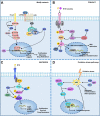The Mechanisms of HBV-Induced Hepatocellular Carcinoma
- PMID: 34046368
- PMCID: PMC8147889
- DOI: 10.2147/JHC.S307962
The Mechanisms of HBV-Induced Hepatocellular Carcinoma
Abstract
Hepatocellular carcinoma (HCC) is a common malignancy, and the hepatitis B virus (HBV) is its major pathogenic factor. Over the past decades, it has been confirmed that HBV infection could promote disease progression through a variety of mechanisms, ultimately leading to the malignant transformation of liver cells. Many factors have been identified in the pathogenesis of HBV-associated HCC (HBV-HCC), including HBV gene integration, genomic instability caused by mutation, and activation of cancer-promoting signaling pathways. As research in the progression of HBV-HCC progresses, the role of many new mechanisms, such as epigenetics, exosomes, autophagy, metabolic regulation, and immune suppression, is also being continuously explored. The occurrence of HBV-HCC is a complex process caused by interactions across multiple genes and multiple steps, where the synergistic effects of various cancer-promoting mechanisms accelerate the process of disease evolution from inflammation to tumorigenesis. In this review, we aim to provide a brief overview of the mechanisms involved in the occurrence and development of HBV-HCC, which may contribute to a better understanding of the role of HBV in the occurrence and development of HCC.
Keywords: carcinogenic mechanisms; hepatitis B virus; hepatocellular carcinoma; therapy.
© 2021 Jiang et al.
Conflict of interest statement
The authors report no conflicts of interest in this work.
Figures




Similar articles
-
Somatic mutations, viral integration and epigenetic modification in the evolution of hepatitis B virus-induced hepatocellular carcinoma.Curr Genomics. 2014 Dec;15(6):469-80. doi: 10.2174/1389202915666141114213833. Curr Genomics. 2014. PMID: 25646075 Free PMC article.
-
Molecular mechanisms of viral hepatitis induced hepatocellular carcinoma.World J Gastroenterol. 2020 Oct 14;26(38):5759-5783. doi: 10.3748/wjg.v26.i38.5759. World J Gastroenterol. 2020. PMID: 33132633 Free PMC article. Review.
-
Virus-induced hepatocellular carcinoma with special emphasis on HBV.Hepatol Int. 2017 Mar;11(2):171-180. doi: 10.1007/s12072-016-9779-5. Epub 2017 Jan 17. Hepatol Int. 2017. PMID: 28097530 Review.
-
Hepatitis B Virus-Associated Hepatocellular Carcinoma.Adv Exp Med Biol. 2017;1018:11-21. doi: 10.1007/978-981-10-5765-6_2. Adv Exp Med Biol. 2017. PMID: 29052129 Review.
-
Mechanisms of HBV-induced hepatocellular carcinoma.J Hepatol. 2016 Apr;64(1 Suppl):S84-S101. doi: 10.1016/j.jhep.2016.02.021. J Hepatol. 2016. PMID: 27084040 Review.
Cited by
-
Genome-wide loss-of-function genetic screen identifies INSIG2 as the vulnerability of hepatitis B virus-integrated hepatoma cells.Cancer Sci. 2024 Mar;115(3):859-870. doi: 10.1111/cas.16070. Epub 2024 Jan 29. Cancer Sci. 2024. PMID: 38287498 Free PMC article.
-
Comprehensive Analysis of TRIM Family Genes in Hepatitis Virus B-Related Hepatoma Carcinoma.Front Genet. 2022 Jul 7;13:913743. doi: 10.3389/fgene.2022.913743. eCollection 2022. Front Genet. 2022. PMID: 35873464 Free PMC article.
-
Advances in Multi-Omics Applications in HBV-Associated Hepatocellular Carcinoma.Front Med (Lausanne). 2021 Sep 30;8:754709. doi: 10.3389/fmed.2021.754709. eCollection 2021. Front Med (Lausanne). 2021. PMID: 34660653 Free PMC article. Review.
-
Sortilin 1 Promotes Hepatocellular Carcinoma Cell Proliferation and Migration by Regulating Immune Cell Infiltration.J Oncol. 2022 Jul 8;2022:6509028. doi: 10.1155/2022/6509028. eCollection 2022. J Oncol. 2022. PMID: 35847356 Free PMC article.
-
Overview of hepatocellular carcinoma: from molecular aspects to future therapeutic options.Cell Adh Migr. 2023 Dec;17(1):1-21. doi: 10.1080/19336918.2023.2258539. Epub 2023 Sep 19. Cell Adh Migr. 2023. PMID: 37726886 Free PMC article. Review.
References
Publication types
LinkOut - more resources
Full Text Sources
Other Literature Sources
Research Materials
Miscellaneous

